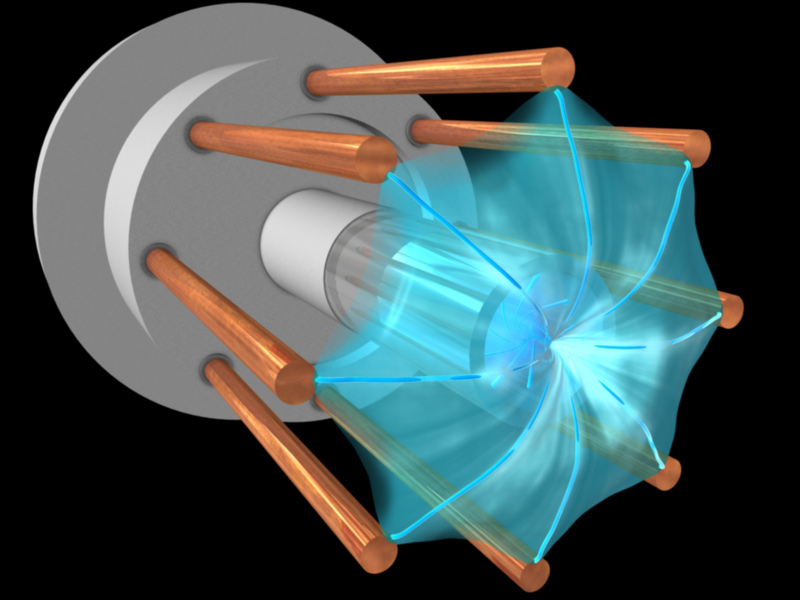Fusion breakthrough


Lawrenceville Plasma Physics Inc. said it has confined a gas at 1.8 billion degrees C. Its previous highest temperature was 1.1 billion degrees C, which it hit last year and which it says had stood as a fusion industry record since 1978.
As hot as the earlier 1.1 billion degrees C might sound to you and me, it was too frigid to support LPP's "aneutronic" approach to fusion.
"The new work shatters those long-standing records, and, most importantly, achieves the temperature needed to burn aneutronic fuels," the Lawrenceville, N.J.-based startup says in a press release.
Unlike today's nuclear fission, nuclear fusion combines atoms, rather than splits them apart. Many people regard it as a potentially safe, cheap, CO2-free source of power that does not pose serious nuclear waste problems the way uranium-based fission does. It does not use uranium. Rather, it tends to deploy different forms of hydrogen, among other fuels.
The "aneutronic" form of fusion would use common hydrogen, rather than the isotopes of hydrogen on which several other fusion projects rely. ("Aneutronic" means "without neutrons" - normal hydrogen has no neutrons in its nucleus, just a proton).
If perfected, aneutronic fusion could be the ultimate of the ultimate power source, because it generates electricity directly, without using a turbine. Other forms of fusion, as well as nuclear fission, generate heat that creates steam (sometimes another gas) that drives a turbine.
But aneutronic requires severely higher temperatures than other forms of fusion, which theoretically operate at around 100 million-to-150 million degrees C. (And then there's "cold fusion" which we'll save for a rainy day; feel free to comment below).
LPP's 1.8 billion degrees in principle topples the temperature barrier. The accomplishment marks the second breakthrough of three that LPP says is necessary for it to commercialize fusion. LPP had already demonstrated that it can confine fuel long enough to burn it, at tens of nanoseconds.
Now for its third and final trick: "We are still far from having sufficient density in the tiny hot regions to get net energy, but that is our next goal," says Eric Lerner, LPP's chief scientist.
LPP director of business development Derek Shannon told SmartPlanet that once it reaches sufficient densities, it will have also achieved a net balance of energy output to commercialize a fusion device. In over half a century of research and development, the fusion industry has not yet managed to achieve an economical "gain" of energy out compared to the energy required to produce fusion-based electricity.
Shannon said that LPP could commercialize its fusion device about four years after hitting the required density. It's not clear how long that might take.
"The LPP research team is currently upgrading their fusion device to achieve the higher densities required for net energy, a goal they hope to achieve soon," the press release states.
To reach 1.8 billion degrees C, the company is using a technology known as dense plasma force (DPF), which fires lighting-like magnetized plasma balls of fuel at each other in a compressed space.
LPP is experimenting with a hydrogen isotope, called deuterium, which is one of the two isotopes that "common" (neutronic) fusion uses (the other is tritium). LPP's goal is to eventually use normal hydrogen and boron as its fuel.
Part of its vision is to install small, garage-sized 5 megawatt fusion devices to provide neighborhood power.
Other companies working on aneutronic fusion include Tri-Alpha Energy, a stealth startup in Irvine, Calif. Startup General Fusion of Burnaby, Canada, and Helion Energy of Redmond, Wash., are chasing "neutronic" fusion.
Between them and LPP, it's looking more likely than ever that fusion could hit the market within a decade or so - which is faster than the large, international government backed projects like ITER in France and the National Ignition Facility at California's Lawrence LIvermore National Laboratory will accomplish.
Images from Focus Fusion via Flickr
More nuclear gazing on SmartPlanet:
- Nuclear's back. Oh no it isn't! Oh yes it is!
- China grabbing up uranium to secure nuclear lead
- Nuclear down, CO2 up in Japan, Germany
- Asian Super Grid: How Japan’s anti-nuclear plan could go nuclear
- Fukushima’s lesson: ‘Alternative’ nuclear, not ‘no’ nuclear
- Photo captures Westinghouse’s nuclear knowledge flying around China
- Watch replay of nuclear’s future, with dash of rare earth
- Why safe nuclear will rely on rare earth minerals
- Meet the future of nuclear power: 8 guys in China
- The new face of safe nuclear
And elsewhere:
This post was originally published on Smartplanet.com